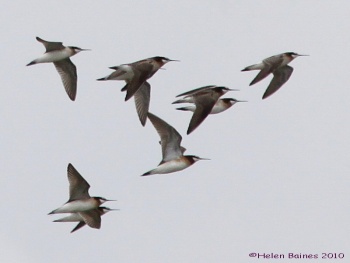(resize photo of female) |
(Video link. References updated. OBI Link removed) |
||
| Line 1: | Line 1: | ||
| + | [[Image:Wilsons_Phalarope.jpg|thumb|500px|right|Female in breeding plumage<br />Photo by {{user|smackay|smackay}}<br />Seattle, [[Washington]], May 2003]] | ||
;[[:Category:Phalaropus|Phalaropus]] tricolor | ;[[:Category:Phalaropus|Phalaropus]] tricolor | ||
| − | + | ||
| + | |||
| + | |||
| + | |||
| + | |||
==Identification== | ==Identification== | ||
23 cm<br /> | 23 cm<br /> | ||
| Line 23: | Line 28: | ||
*White underparts | *White underparts | ||
*Retains dark eyepatch | *Retains dark eyepatch | ||
| − | |||
====Flight==== | ====Flight==== | ||
Shows square white rump and trailing yellow legs . | Shows square white rump and trailing yellow legs . | ||
====Similar Species==== | ====Similar Species==== | ||
Can be confused with [[Lesser Yellowlegs]] and [[Stilt Sandpiper]] in winter plumage. | Can be confused with [[Lesser Yellowlegs]] and [[Stilt Sandpiper]] in winter plumage. | ||
| + | ==Distribution== | ||
| + | [[Image:Phalaropus tricolor (Wilson´s Phalarope).jpg|thumb|350px|right|Wintering<br />Photo by {{user|Raul+Padilla|Raul Padilla}}<br />Singuilucan, [[Mexico]]]] | ||
| − | |||
Breeds in [[Canada]] and [[US]]; winters in western and southern [[South America]]. | Breeds in [[Canada]] and [[US]]; winters in western and southern [[South America]]. | ||
| Line 50: | Line 55: | ||
'''Flight call''': ''vit' or ''chu'' | '''Flight call''': ''vit' or ''chu'' | ||
==References== | ==References== | ||
| − | #{{Ref- | + | #{{Ref-Clements6thAug11}}#Avibase |
#Wikipedia | #Wikipedia | ||
#Collins Bird Guide ISBN 0 00 219728 | #Collins Bird Guide ISBN 0 00 219728 | ||
| Line 58: | Line 63: | ||
==External Links== | ==External Links== | ||
{{GSearch|Phalaropus+tricolor}} | {{GSearch|Phalaropus+tricolor}} | ||
| − | + | <br /> | |
| − | [[Category:Birds]] [[Category:Phalaropus]] | + | {{Video|Wilson's_Phalarope}} |
| + | |||
| + | [[Category:Birds]] [[Category:Phalaropus]] [[Category:Videos]] | ||
Revision as of 13:25, 16 September 2012
- Phalaropus tricolor
Identification
23 cm
- Lobed toes
- Straight fine black bill
Breeding female
- White face
- Gray wings with chestnut bands
- Pinkish foreneck
- Black eyestripe, which continues down sides of neck
- White underparts
- Square white rump
Breeding male - duller than the female; may lack reddish patches
- Brown back
Young birds
- Gray and brown upperparts
- White underparts
- Dark patch through the eye
Non-breeding
- Gray upperparts
- White underparts
- Retains dark eyepatch
Flight
Shows square white rump and trailing yellow legs .
Similar Species
Can be confused with Lesser Yellowlegs and Stilt Sandpiper in winter plumage.
Distribution
Breeds in Canada and US; winters in western and southern South America.
Regular vagrant to the British Isles, usually in the Autumn.
Taxonomy
This is a monotypic species[1].
It has sometimes been placed in a monotypic genus Steganopus[2].
Habitat
Prairie lakes, marshes, pools, shores, mudflats, sand bars and river bankss.
Behaviour
Breeding
The 3-4 eggs are laid in a ground nest near water. The male incubates the eggs and cares for the young. The chicks feed themselves once fledged.
The females leave the breeding grounds soon after laying the eggs.
Diet
Their diet consists mostly of small water insects. They agitate the water by swimming in small circles.
Vocalisation
Voice: a grunted aangh
Flight call: vit' or chu
References
- Clements, JF. 2011. The Clements Checklist of Birds of the World. 6th ed., with updates to August 2011. Ithaca: Cornell Univ. Press. ISBN 978-0801445019. Spreadsheet available at http://www.birds.cornell.edu/clementschecklist/downloadable-clements-checklist
- Avibase
- Wikipedia
- Collins Bird Guide ISBN 0 00 219728
- Collins Field Guide 5th Edition ISBN 0 00 219900 9
- BF Member observations
Recommended Citation
- BirdForum Opus contributors. (2024) Wilson's Phalarope. In: BirdForum, the forum for wild birds and birding. Retrieved 21 May 2024 from https://www.birdforum.net/opus/Wilson%27s_Phalarope
External Links






